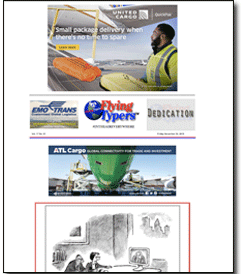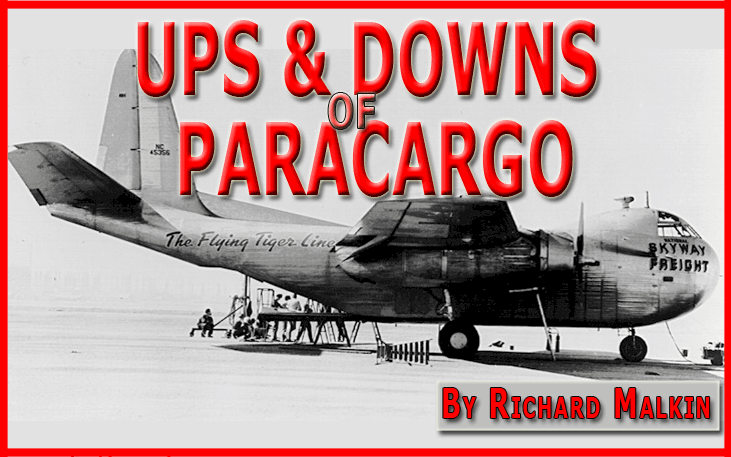
If the dazzling
performance of the transport airplane in World War II paved the way to
a postwar air cargo industry, it also was the birther of paracargo—cargo
delivery by parachute.
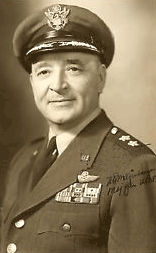 Virtually
a war-born technique, the art and applicability of parachuting gained
as the war progressed in Europe, North Africa and the China-Burma-India
theater. Ammunition, food, medical supplies, mail were airdropped to troops
in battle and those based in inaccessible areas. Ultimately, the military
equipment chuted to earth included such items as Jeeps and howitzers. Virtually
a war-born technique, the art and applicability of parachuting gained
as the war progressed in Europe, North Africa and the China-Burma-India
theater. Ammunition, food, medical supplies, mail were airdropped to troops
in battle and those based in inaccessible areas. Ultimately, the military
equipment chuted to earth included such items as Jeeps and howitzers.
Shortly after the Japanese surrender, Brig.
Gen. W.R. Wolfinbarger, commanding general of the Technical Air Force
(Provisional) stated that, “we must develop our ability to transport
tanks and also endeavor to arrive at methods whereby we will always be
utterly dependent upon fire power and regardless of how necessary and
vital first-class air support might be, it is not considered likely that
air arm will ever entirely replace the infantry’s own weapons.”
(Note the last eleven words’ similarity to the current U.S. military
thinking on its offensive against the Islamic State.)
Over the ensuing decades, the capabilities
of the military cargo parachute—and parachuting—have been
developed to a level undreamed of in earlier years.
But what about commercial
paracargo? Is there a place for the parachute in routine airline cargo
operations? If guns and cigarettes and medicines can be airdropped to
our men in uniform, why not fashion goods and electric supplies and strawberries
to businesses? The possibilities of commercial paracargo sprang to life
in the imaginations of a small handful.
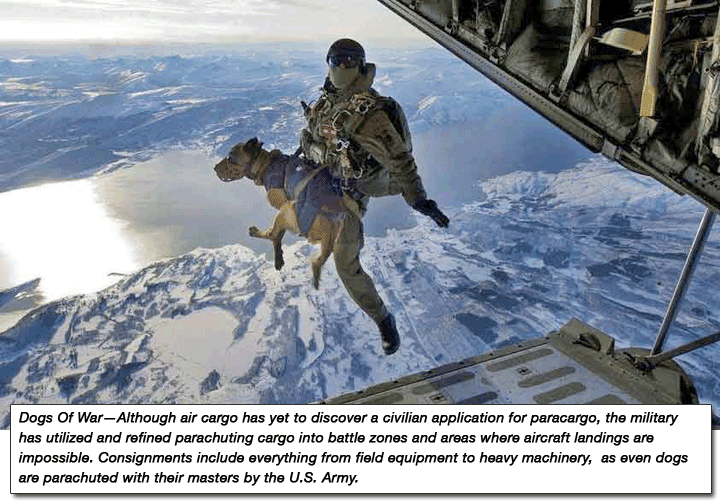
In the Horacian spirit that he who makes
the experiment deserves recognition and the rewards. A Conestoga freighter
in the service of National Skyway Freight (which soon afterward was renamed
Flying Tiger Line) performed a successful series of coast-to-coast airdrops
of silverware. Seventeen boxes of silverware, valued at $30,000 (1946
currency), manufactured by Wallace Silversmiths of Wallingford, Conn.,
were safely floated to predetermined spots by nonoscillative parachutes.
The transcontinental course, starting from a drop at New Haven’s
air facility, proceeded to New York, Newark Philadelphia, Pittsburgh,
Cleveland, Detroit, Chicago, St. Louis, Atlanta, Memphis Tulsa, Dallas,
San Diego, Los Angeles, and San Francisco. Barely a year after the war,
it was air cargo history in the making.
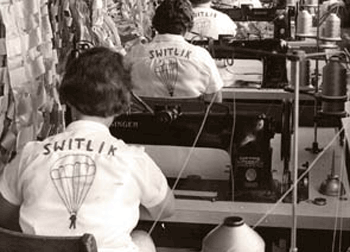 Then
there was the case of the Switlik Parachute Co., which was determined
to prove that, with the right kind of packaging, a long list of delicate
products could be airdropped without a scratch. Then
there was the case of the Switlik Parachute Co., which was determined
to prove that, with the right kind of packaging, a long list of delicate
products could be airdropped without a scratch.
Together with the Manhattan Storage &
Warehouse Co., Switlik arranged for a series of fifteen tests at Trenton’s
Mercer Airport. A Waco flying at 115 miles per hour at 250 feet unloaded
its test cargo in a 15-18 mile gusty.
A group of air transport specialists was
among the observers as the first of the fifteen test containers made a
soft landing. 1 contained a set of elegant china consisting of forty-two
pieces, plus a range of glassware. Not a crack. Not a scratch. The observers
nodded their approval. When the second container was opened, it revealed
several hundred phonograph records of the original seventy-eight rpm type,
an extremely fragile product. Once again, a flawless arrival. A third
airdrop brought table-model radio, a fourth delivered vials of medicines—and
so on with a hundred percent record of safety.
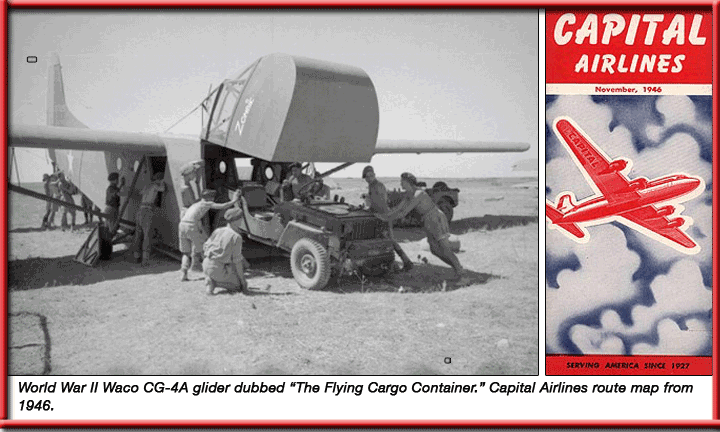 |
When the same tests
were repeated at the airport in the nation’s capital, the Waco gave
way to Capital Airlines, which, at 200 feet, flew at 135 miles per hour.
The chutes were opened by a static line. Landings were completed safely
within a few feet of each other.
News about paracargo activity abroad was
few and infrequent. There were scattered reports from London, Paris, Frankfurt
and Amsterdam. South America appeared to offer brighter prospects for
the cargo chute’s promoters who, in most or all cases, were from
the United States.
Demonstrations were organized in Ecuador—at
Guayaquil and Quito, the former only a few feet above sea level, and the
latter situated at an altitude of 8,500 feet. Because of the vast difference
between the test’s altitudes, the established rate of descent for
precision drops necessitated revision.
These tests involved foodstuffs dropped
by Latin American Airways.
Matters were a bit different in Colombia.
There was El Gato, reportedly a misnomer, a seventy-five pound black Belgian
shepherd supplied by the National University of Colombia’s College
of Veterinary Medicine, which sought to determine an airdrop’s effect
on a dog’s respiration, muscles and heartbeat. It
was a 200-foot drop without ill effect.
An ensuing test at a military airbase located
at an altitude exceeding Quito’s paracargo test was the star of
a series of hard-freight drops, including ordnance parts, oil and gasoline
in cans reinforced and cushioned by wooden containers, trucks, tires,
processed foodstuffs, and medical and pharmaceutical supplies.
There was yet another series of tests in
that country, these requiring the cooperation of Willis Air Service. The
drops embodied a mix of scientific and commercial candidates. A complement
of scientists was on hand to witness a string of live creatures dropped
from a height of 100 feet: A crate of leghorn chickens, a second crate
containing a pair of rabbits, a full-size sheep, a cat, several dozen
chicken eggs, and—surprise!—bull semen.
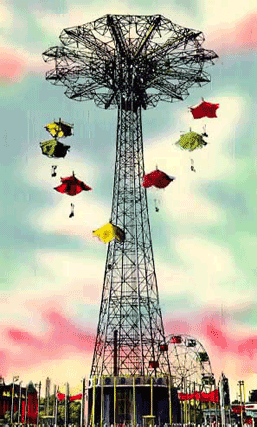 The Big Jump—Inspiration for parachuting everything
from people to cargo undoubtedly received a huge lift from the Parachute
Jump at the 1939 World’s Fair in New York City, which was viewed
by and hosted millions. The Big Jump—Inspiration for parachuting everything
from people to cargo undoubtedly received a huge lift from the Parachute
Jump at the 1939 World’s Fair in New York City, which was viewed
by and hosted millions.
After the Fair the Jump was moved to Coney
Island Amusement Park in Brooklyn, New York, where it still stands today,
although it has been out of use for decades. Back
home, there was industry rumor that Railway Express Agency was casting
an interested eye on paracargo as a potential complement to its air express
division. The one big question that begged solution: how to marry the
parachute to a system with its nationwide 23,000 offices. If, indeed,
air express considered its possible application to a thriving service,
it provided since 1927, nothing came of it.
I was the young editor of a fledgling air
cargo publication in the earliest days of an exciting new industry, and
I had come to anticipate that occasional letter or phone call remarking
about a praiseworthy quotation or blasting me for downright muddle-headedness.
Then, too, there was that ardent, self-confident person who had a blockbuster
of an idea that he would lie to see in print (with his byline in large
boldface caps), and Mr. Johnson—I will call him that—perfectly
fit the characterization.
Mr. Johnson was an employee of Air Express International, which, before
the war, had forwarded parcels to Germany via Zeppelin. This fact had
germinated in his mind, and he arrived at the conviction that the United
States Post Office could well use the flight prowess of an airship—a
blimp would be fine—to serve as an airborne postal handling and
distribution operation. The sorted mail, dumped in sacks, would be airdropped
to designated spots along a route covering a number of states.
I complimented Mr. Johnson and acknowledged
that I thought an airborne post office was a fresh idea. But I had one
bothersome reservation. The speed of a blimp could not be equated with
the speed of an airplane. Offhand, without numbers to support my reaction,
I believed an all-surface operation was still preferable.
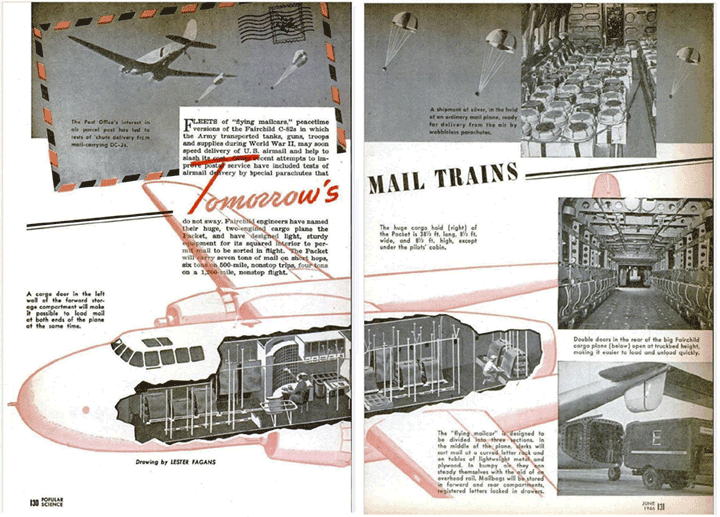 |
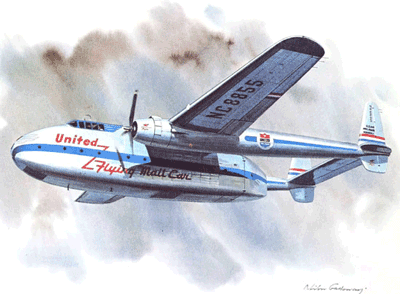 I mention the foregoing incident because it returns to memory Fairchild’s
proposed version of a flying post-office call the Mailcar—no less,
a dressed-up all-cargo Packet. It was the equivalent of a railroad mailcar.
I mention the foregoing incident because it returns to memory Fairchild’s
proposed version of a flying post-office call the Mailcar—no less,
a dressed-up all-cargo Packet. It was the equivalent of a railroad mailcar.
Fairchild engineers went to work on the
aircraft, adapting its interior to post office requirements: sorting table,
letter rack, parachutes, locked drawers for registered air mail, bag racks,
all lighter weight than the same equipment used in the railroad mailcar.
Among the innovations was an oval letter
case with every pigeonhole equally accessible. The mail clerk’s
ability to communicate with every section of the plane, including the
cockpit, was made possible by an intercom phone.
The sorting function would apply to only
about one-quarter of the mail loaded aboard the plane, the balance packed
into storage bags addressed to specific locations. Tonnage varied with
the nonstop distance flown: 500 miles, six tons; 1,200 miles, four-plus
tons. Paracargo was considered, but it was set aside as a possible option.
The capability of the helicopter to land
nearly anywhere “on a dime,” quickly sounded the death knell
for paracargo’s potential as a local mail delivery system.
Periodic reports reflected the military’s
steady advances in utilization of the cargo parachute. Aficionados
of commercial paracargo often turned a respectful eye toward the military
in hopeful search for some possible commercial application. One such instance
involved the Air Materiel Command’s equipment laboratory at Wright-Patterson
Air Force Base working cooperatively with Ryan Industries. Their engineers
developed a monorail delivery system—a single rail running the full
length of a cargoplane’s fuselage. The rail could accommodate up
to twenty parapacks, each containing 500 pounds of supplies. These were
suspended on trolleys moving on rollers of a unique design. A “salvo
button”—this was described as a “key” to the operation—required
only a single push by the jumpmaster for the cargo doors in the forward
section of the plane to open. With a driving motor activated, the trolleys
unlocked individually, and the parapacks were released as each reached
the drop point above the cargo doors.
The system enabled ten tons to drop to a
1,500-foot area in a seven-second pass. (During World War II the delivery
rate was 800 pounds). The developers were duly applauded, their accomplishment
praised, and quickly forgotten in a commercial air freight community set
on a different course.
I’m not sure there still are paracargo
zealots of the Forties-to-the-Sixties stripe still around, but the science
of parachuting commercial shipments has not expired. It is employed in
specific cases everywhere in the world, probably mostly at difficult or
inaccessible places, or emergency or disaster areas.
The following is an actual typical airdrop
to Shell Co. engineers working in a South American jungle: five pigs,
one sheep, cases of eggs, boxes of fresh vegetables, cases of canned goods,
drums of oil, jerrycans of gasoline, dynamite, sacks of rice, bags of
flour, pickaxes, and mail. The delivery operation required only
twelve minutes for forty chutes dropped in threes to make their descent.
Had there been a more spacious area for acceptance of the drops, the total
delivery would have consumed markedly less time.
Richard Malkin
|




 One
of the most important pioneering journalists in air cargo history, Richard
Malkin is the only air cargo reporter who covered the Berlin Airlift;
with that one act, he practically invented air cargo journalism.
One
of the most important pioneering journalists in air cargo history, Richard
Malkin is the only air cargo reporter who covered the Berlin Airlift;
with that one act, he practically invented air cargo journalism. Vol.
17 No. 80
Vol.
17 No. 80